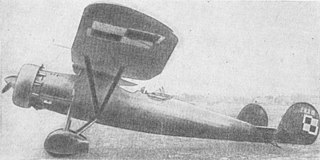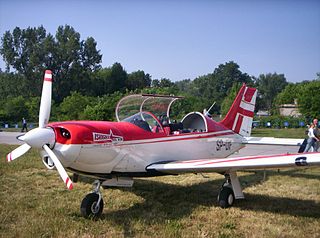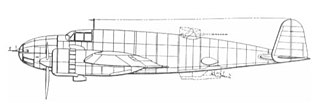Operators (planned)
 Poland
Poland
| LWS-7 Mewa II | |
|---|---|
| General information | |
| Type | Reconnaissance |
| Manufacturer | LWS |
| Primary user | Polish Air Force |
| Number built | None, project only |
The LWS-7 Mewa II ("Seagull") was a Polish observation and close reconnaissance aircraft, designed in the 1939 by the LWS factory as a development of the earlier LWS-3 Mewa. Aircraft development was ordered by the Polish Air Force, but no prototypes were built.
In 1939, the LWS-7 Mewa II was being developed at the LWS as the development of the LWS-3 Mewa . New wings and a semi-monocoque fuselage with less drag were introduced. It was to be fitted with a more powerful 916 hp (683 kW) PZL Pegaz XX engine (Bristol Pegasus XX) or a planned 1000 hp (750 kW) PZL Waran. A maximum speed of 400–420 km/h was estimated.
Before the war, only a wooden model for aerodynamics tests was made. Tests performed by Aerodynamic Institute of Warsaw University of Technology showed that the maximum speed of the LWS-7 could be estimated at 420–425 km/h - about 60 km/h more than the LWS-3 Mewa.
Complete technical drawings were prepared in Summer 1939 (still not confirmed) and the first prototype was planned to be built in Autumn 1939. First flight was planned in Spring or Summer 1940 and start of production was planned for Autumn/Winter 1940. The first production LWS-7 Mewa II would be handed over to Polish Air Force in early 1941. All these plans were halted due to the outbreak of World War II.
Drawings of LWS-7 were evacuated in September 1939 to the Polish embassy in Romania by the LWS director Aleksander Sipowicz. Many publications claim that they were handed over to Bulgarians, but it is not clear (possibly, it concerned the LWS-3B plans, in fact).
Data from [1]
General characteristics
Performance
Armament
Related development
Aircraft of comparable role, configuration, and era

The PZL.23 Karaś was a Polish light bomber and reconnaissance aircraft designed in the mid-1930s by PZL in Warsaw.

The PZL.37 Łoś ('moose') was a Polish twin-engined medium bomber designed and manufactured by national aircraft company Państwowe Zakłady Lotnicze (PZL). It is sometimes incorrectly referred to as "PZL P.37", but the letter "P" was reserved for fighters of Zygmunt Puławski's design.
The LWS-6 Żubr was a twin-engined medium bomber designed and produced by the Polish aircraft manufacturer LWS. It was only produced in limited numbers and was used for training purposes as it proved to be inferior to the contemporary PZL.37 Łoś medium bomber.

The PZL P.11 is a Polish fighter aircraft, designed and produced in the early 1930s by Państwowe Zakłady Lotnicze. Possessing an all-metal structure, metal-covering, and high-mounted gull wing, the type held the distinction of being widely considered the most advanced fighter aircraft in the world at the time of its introduction into service.

The PZL P.7 was a Polish gull wing monoplane fighter aircraft designed in the early 1930s at the PZL factory in Warsaw. It was the main fighter of the Polish Air Force between 1933 and 1935. The PZL P.7 was replaced in Polish service by its follow-up design, the PZL P.11c. More than 30 PZL P.7 fighters remained in service during the Invasion of Poland, scoring several kills despite its obsolescence.

The RWD-14 Czapla was a Polish army cooperation aircraft, designed in the mid-1930s by the RWD team, and produced in the LWS factory from 1938. A series of 65 aircraft were built and most were used by the Polish Air Force observation squadrons during World War II in 1939.

The LWS-3 Mewa ("Seagull") was a Polish observation and close reconnaissance aircraft, designed in the late-1930s by the LWS factory. It was ordered by the Polish Military Aviation, but did not manage to enter service before the outbreak of World War II.

The LWS-2 was the Polish air ambulance aircraft prototype, designed in the late-1930s in the LWS factory.

PZL.46 Sum (sheatfish) was a light bomber developed by Państwowe Zakłady Lotnicze shortly before World War II, which, was directed to serial production in the spring of 1939. These planes were in production, but the Polish industry did not manage to produce them before the outbreak of the war.

PZL.50 Jastrząb (Hawk) was a Polish late 1930s fighter aircraft designed by Wsiewołod Jakimiuk at Państwowe Zakłady Lotnicze. The single-seat low-wing monoplane was to serve as a multi-purpose fighter and escort to replace all other fighters in the Polish Military Aviation. Designed after 1936, its prototype first flew in February 1939. By September, the first production aircraft were nearing completion, but further development was interrupted by the Nazi-Soviet Invasion of Poland.

The PZL.38 Wilk (wolf) (PZL-38) was a Polish heavy fighter developed and manufactured by PZL state factory in 1937. Intended for use primarily as a fighter-bomber, the Polish Air Force also envisioned it replacing light fighters in long-range operations, along with being able to serve as a light bomber. Only two examples were built before the project was cancelled in favor of a planned improved variant, the PZL.48 Lampart.

The PWS-19 was a Polish reconnaissance and bomber plane prototype of the 1930s, constructed in the PWS.

PZL M26 Iskierka or M26 Airwolf is a Polish trainer and aerobatic aircraft, designed at WSK PZL-Mielec.

The PZL P.6 was a Polish fighter, designed by the engineer Zygmunt Puławski, manufactured by PZL state-owned factory. It remained a prototype and did not go into production.
The Lublin R-XX was the Polish torpedo bomber floatplane, designed in the early 1930s in the Plage i Laśkiewicz factory in Lublin. It remained a prototype.

The PZL.43 was a Polish light bomber and reconnaissance aircraft designed in the mid-1930s by PZL in Warsaw. It was an export development of the PZL.23 Karaś. Its main user was the Bulgarian Airforce who called it the Chaika.
The PZL.48 Lampart (leopard) was a Polish heavy fighter-bomber design, that remained only a project, owing to the outbreak of World War II.

The PZL.49 Miś was a Polish twin-engined medium bomber design that remained only a project due to the outbreak of World War II. The PZL.49 was based on the contemporary PZL.37 Łoś and was to replace it at production lines at Państwowe Zakłady Lotnicze.
PZL.53 Jastrząb II was a project of Polish pre-war fighter aircraft developed from PZL.50 Jastrząb and designed by Wsiewołod Jakimiuk of the PZL works. A single-seat low-wing monoplane was to serve as a multi-purpose fighter and escort and reinforcement for PZL.50 Jastrząb in the Polish Air Force.

PZL.55 was a Polish pre-war project of a fighter aircraft, created at Państwowe Zakłady Lotnicze by Jerzy Dąbrowski. The design was for a single-seat low-wing all-metal monoplane. It was planned that the plane would replace obsolete fighters and lead to a significant increase in the capabilities of Polish Military Aviation.